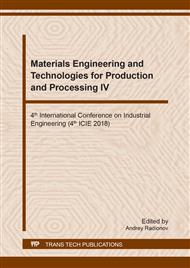[1]
Y.V. Yavorovsky, D.O. Romanov, V.V. Sennikov, I.A. Sultanguzin, A.S. Malenkov, Е.V. Zhigulina, A.V. Lulaev, Application of thermohydraulic dispatcher in low temperature district heating systems for decreasing heat carrier transportation energy cost and increasing reliability of heat supply, Journal of Physics: Confеrence Series, 891(1) (2017).
DOI: 10.1088/1742-6596/891/1/012167
Google Scholar
[2]
V.V. Sennikov, A.A. Genvarev, Y.V. Yavorovsky, et al, Application of thermohydraulic dispatcher in district heating systems, Vestnik IGEU, 4 (2009) 27-30.
Google Scholar
[3]
V.V. Sennikov, A.A. Genvarev, Y.V. Yavorovsky, et al, Application of thermohydraulic dispatcher in heating substations of centralized heat supply system. Vestnik IGEU, 4 (2012) 15-20.
Google Scholar
[4]
Aibin Yan, Jun Zhao, Qingsong et al, Hydraulic performance of a new district heating systems with distributed variable speed pumps, Applied Energy. 112 (2013) 876-885.
DOI: 10.1016/j.apenergy.2013.06.031
Google Scholar
[5]
Hai Wang, Haiying Wang, Tong Zhu, A new hydraulic regulation method on district heating system with distributed variable-speed pumps, Energy Conversion and Management, 147 (2017) 174-189.
DOI: 10.1016/j.enconman.2017.03.059
Google Scholar
[6]
S.T. Kasyuk, About energy saving policy and increasing energy efficiency in EU Energosovet, (2016) 77-81.
Google Scholar
[7]
M.A. Ancona, L. Branchini, et al, Smart District Heating: Distributed Generation Systems' Effects on the Network. Energy Procedia, 75 (2015) 1208-1213.
DOI: 10.1016/j.egypro.2015.07.157
Google Scholar
[8]
E.Y. Sokolov, District heating cogeneration and heating networks. Publishing house MPEI, (2009).
Google Scholar
[9]
Sarbu Ioan, Valea Emilian Stefan, Energy savings potential for pumping water in district heating stations. Sustainability, 7 (2015) 5705-5719.
DOI: 10.3390/su7055705
Google Scholar
[10]
X.J. Sheng, L. Duanmu, Electricity consumption and economic analyses of district heating system with distributed variable-speed pumps. Energy Build, 118 (2016) 291-300.
DOI: 10.1016/j.enbuild.2016.03.005
Google Scholar
[11]
X.J. Sheng, L. Duanmu, Energy saving analyses on the reconstruction project in district heating system with distributed variable-speed pumps. Applied Thermal Engineering, 101 (2016) 432-445.
DOI: 10.1016/j.applthermaleng.2016.01.059
Google Scholar
[12]
Henrik Lund, Sven Werner, Robin Wiltshire, Svend Svendsen, Jan Eric Thorsen, Frede Hvelplund, Brian Vad Mathiesen, 4th Generation District Heating (4GDH): Integrating smart thermal grids into future sustainable energy systems, Energy, 68 (2014).
DOI: 10.1016/j.energy.2014.02.089
Google Scholar
[13]
M.A. Ancona, Michele Bianchi, Lisa Branchini, Francesco Melino, District Heating Network Design and Analysis, Energy Procedia, 45 (2014) 1225-1234.
DOI: 10.1016/j.egypro.2014.01.128
Google Scholar
[14]
Urban Persson, Sven Werner. Heat distribution and the future competitiveness of district heating, Applied Energy, 88(3) (2011) 568-576.
DOI: 10.1016/j.apenergy.2010.09.020
Google Scholar


